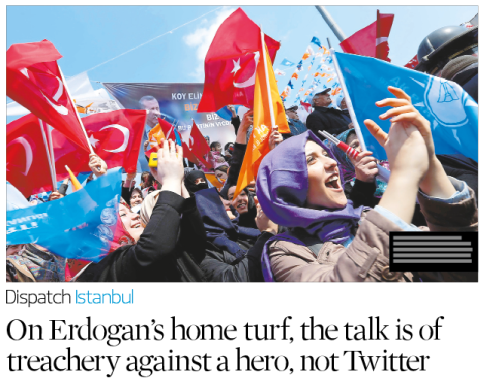“Partial” quotations – or to be more specific, “single-word” quotations – are widespread in journalism and have always been a little annoying. Now a coherent rebellion seems to be taking shape in the editosphere. John McIntyre writes at You Don’t Say:
“I suppose that what, if anything, is in the reporter’s mind is an impulse to indicate that the subject’s exact words are being quoted. But this can lead to unintended consequences, especially when the single word within quotation marks is unremarkable.
Try this: McIntyre said that he was ‘honored’ to be invited to speak to a group of Towson University students about editing.
The sentiment and the word are both commonplace, and eliminating the quotation marks would allow the reader to pass over this flat and unremarkable sentence quickly.
But the quotation marks catch the reader’s eye, leading to a question: I wonder what he meant by that.”
And he links to Stan Carey, who amplifies the point:
“Quotation marks can also highlight that a word is being used somehow peculiarly – a writer may wish to indicate irony, inaccuracy, or scepticism, for example; used this way, they’re called scare quotes …
The Oxford Manual of Style says scare quotes may serve ‘to hold up a word for inspection, as if by tongs, providing a cordon sanitaire between the word and the writer’s finer sensibilities’. It’s a technique that quickly wears thin, so style guides sometimes caution against its excessive use. And there’s a related problem: non-standard emphasis.
Sometimes people use quotation marks to stress a word or phrase, and this clashes with the general understanding of how the marks – and scare quotes – are properly used. In a comment to my recent article on the use of apostrophes, Kristen said she found this habit troublesome, offering the example ‘fresh’ fish, which inadvertently casts doubt on the freshness of the fish.”
You Don’t Say’s advice is to restrict single-word quotations that are “foreign, technical, or exotic”. But there is one other aspect of the subject to consider.
In the rarefied world of political and diplomatic reporting, a choice of word, or a change in vocabulary, can be a story in itself. For example, there was a minor sensation on the Tribune’s business desk five years ago when the governor of the Bank of England first used the word “recession” in public as the financial crisis deepened, after a year of being determined not to “talk the economy down”.
And sometimes the very terms used by opposing sides in a conflict crystallise the point of dispute. Take this quote from a Guardian article about the Ukraine crisis:
“The Russian foreign minister, Sergei Lavrov, has accused Ukraine of violating an accord reached in Geneva last week aimed at averting a wider conflict.
‘Steps are being taken – above all by those who seized power in Kiev – not only that do not fulfil, but that crudely violate the Geneva agreement,’ he said on Monday.
Lavrov also told a news conference that a deadly gunfight on Sunday near Slavyansk, a Ukrainian city controlled by pro-Russian separatists, showed Kiev did not want to control ‘extremists’.”
“Extremists”, in quotes, is what the conflict is all about. Are the Kiev protesters and their interim administration a front for the neo-Nazi nationalist right? That is the whole basis on which Russia says it is intervening. Or is the characterisation of the new government as “extremists” simply Moscow’s cynical pretext for its expansionist agenda?
It’s hardly a technical or exotic word, but it’s certainly a loaded one: and you can’t take it out of its quotes. Once out, it becomes spoken in the reporter’s voice, not Lavrov’s, and at that point the paper, subtly, implicitly, takes sides.
Liberator/terrorist, anti-abortion/pro-life, Burma/Myanmar, AD/CE: all these little terms have lengthy stylebook entries spelling out the implications that choosing one over the other carries. Reporters and editors aiming to be neutral need to be acutely sensitive to the rhetoric used by both sides in war and political debate. Better a single-word quote than a suggestion of unconscious bias or naiveté.
Foreign, technical, exotic – that’s a good guide for when to allow the single-word quote. But there’s also another: “political”.













